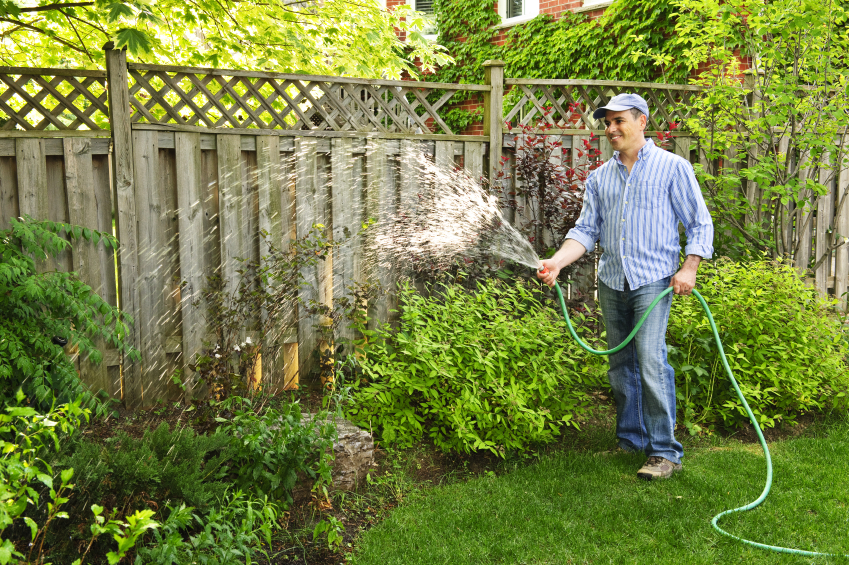How Tall a Fence Do You Need?

How tall a fence needs to be depends on its intended use, building code, and of course your personal tastes. When you’re setting out with a fencing project, you should think about what you’re using it for so you can determine if any local building code regulations affect you and select the best materials. Officials at your city hall or planning commission should be able to help you with information about fencing ordinances, as can professional fence contractors.
What Is the Fence for?
The first question is what you’ll be using the fence for. Some common applications include: privacy, keeping animals in, keeping animals out, hiding an unsightly nuisance, or securing an area like a pool to ensure that children and animals don’t fall in. In all these instances, the material used can be as important as the height, which is something important to consider.
Privacy and Concealment Fences
Privacy fences and those intended to hide an unsightly object (like your garbage can) may range from four to eight feet high, but be warned that many cities cap fence heights at six feet, so you’d need to apply for a variance to install a higher fence. For that, you’d probably need the cooperation of the neighbors who will be looking at it, and it helps to present plans detailing how you’ll keep the fence aesthetically pleasant and in good shape. Be aware that living fences made from plants are also subject to regulation in many cities, and you’ll need to commit to trimming and maintenance to keep them at the correct height.
Animal Fencing
If you want to know how tall a fence you need for keeping animals in, that depends on the critters. Chickens can usually be kept in a pen with a six foot fence which keeps them from flying over, although you may want to cover the top with bird netting to keep hawks out. Like rabbits (who can be perfectly comfortable and safe with a two to three foot fence), chickens also need fencing that extends at least six inches into the ground to discourage digging. Dogs can typically be secured with four to six foot fences, depending on breed; German Shepherds, for example, need a six foot fence because they can jump quite high, especially when startled.
Likewise, goats usually require about a four to six foot fence. Goats are also quite agile and skilled when it comes to escaping, so make sure to accompany your fence with a stout gate and stretch the wire tightly to make it harder for your goats to get out. Sheep and cattle tend to be less adventurous when it comes to orchestrating escapes, so their fencing can range from four to five feet, but make sure your gates remain secure, because herds do tend to follow each other out of an open gate and in the direction of new pasture or other sights of interest.
Deer Fencing
Gardeners often want to keep deer out of their vegetables or flowers. How tall a fence is needed for deer can vary. Eight feet is usually sufficient, although some gardeners may extend the fence even higher. If the fence is made from a solid material, four to six feet can be effective because the deer cannot see what is inside, and thus they’ll be afraid to hop the fence even if they smell something enticing inside. If you build a six foot fence at approximately a 45 degree angle, this can also be effective, because the deer won’t want to jump the angled fence.
Keep out Dogs
Dogs can be kept out with a six foot fence, which should ensure that most breeds won’t be able to get into the yard. If dogs harassing chickens and other livestock are a recurring problem, check on local laws. You can report stray dogs to animal control, and you can also file complaints against the owners of nuisance dogs. While you may want to avoid neighborly feuds, unsecured dogs tend to be extremely irritating and they might cause you financial losses if your livestock is killed or frightened so they don’t produce milk or eggs, so don’t be afraid to take steps to resolve the problem—the law is usually in your favor!
Pool Fences
Pool fences should be at least four feet high, according to municipal code (some cities require higher fencing). This height discourages children and small animals who could be at risk of walking up to the pool and falling in. It’s important to install a locking gate as well, and you may also want to consider a locking pool cover. While these measures can be a pain when you want to swim, they protect the health and safety of the small and vulnerable occupants of your neighborhood, and they also protect you from legal liability: in the event you are served with an attractive nuisance suit, you can demonstrate that you took every reasonable measure to make it difficult to access your pool.
s.e. smith writes for Networx.com.
Updated November 21, 2018.
Looking for a Pro? Call us (866) 441-6648

Fencing Average Costs
Fence Contractors Experiences

Rotted Fence Repair Taken Care Of Fast And Efficiently

My New Fence Features Excellent Workmanship



